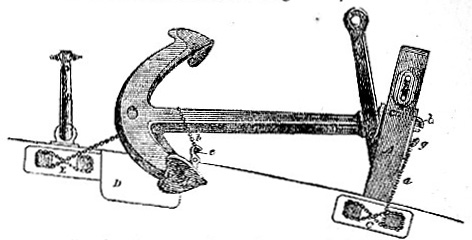Stockless Anchor. Stowing Bower Anchor.
Stowing the Bower Anchor
A bower anchor is stowed in H. M. service as shown in fig. 7. A, is the cathead; B, the fish davit; C, and E, bollards ; d, the bill-board. The anchor is held in place by the two chains, a and b, termed the cat-stopper and shank painter respectively, each of which is fitted with a long link at one end. A bolt b, about 5 to 6 inches long, is fixed on the side of the cathead, on a hinge at its lower end; it is held in the upright position by another bolt c, which passes through the cathead, and is worked by a lever d; d is provided with the hole at the end for a lanyard, so that two or three men can pull it. This whole arrangement is termed a slip-stopper.
A somewhat similar combination of bolts and levers is fitted close to the bill-board D, e being a short bolt secured at its lower end with a hing to the ships side; and f a hooked lever which holds in its upright position; f has a socket at its board end, to which shifting arm, provided with a lanyard like the lever d, is fitted. The cat-stopper is rove through the shackle of the anchor, and the long link placed over the bolt b; it is then passed over a cleat g, on the side of the cathead, and belayed at the bollards C. The end of the shank painter is passed under the the crown and over the shank; its long link is placed over the bolt b, and it is belayed at the bolards E.
When it is desired to let go the anchor, the arm is shipped at f, and the lanyards at f and d are manned; then, at the word of command (given if the ship is rolling, when she lurches towards the side on which the anchor is stowed), the men pull the lanyards, b and e are released simultaneously, the links of the cat-stopper and shank painter drop off, and the anchor falls clear of the ship. In merchant ships it is not usual to fit the second slip-stopper, b and e; in the case it is necesary, before letting go, to "cock-bill" the anchor, -- that is, ease away the shank painter, that the anchor hangs by the cathead alone.
The next thing is to "weigh" the anchor. It is hove up by the capstan, and when it appears at the bows, the operations of "catting" and "fishing" have to be performed. A chain called the "cat pendant" is rove over the sheave h in the cathead, and shackled to a short piece of similar chain attached to the anchor at the other; the inboard end of the cat pendant is taken to a leading block on the opposite side of the ship, and a purchase tackle attached to it, as to give the men a run right aft.
When all is ready, the word is given, and the men run away with the purchase until the anchor hangs from the cathead instead of the hawse-pipe; it is then said to be "catted." A chain rove through the block at the end of the fish davit, and having a large hook at the end, is then hooked to the inner arm of the anchor, which is then raised and swung inboard (the fish davit being made to revolve), so that the fluke rests upon the bill-board D, and the anchor is "fished." The cat-stopper and the shank painter are then rove, and all made ready to let go again at a moments notice.
The cathead shown in the figure is made of plates and angled irons, and similar in shape to the old wooden catheads; it is fitted with a single sheave h, made to swivel so as to give a fair lead for the chain when the anchor is at the hawse-pipe. Catheads are frequently made of solid forgings, with a block hanging from the head of the cat pendant or fall. In ships designed for ramming, the cathead is made to revolve like the fish davit B, so that it can be turned inboard, and there will be no projection on the bow to foul the enemy's rigging.
Read the rest of this article:
Anchor - Table of Contents
